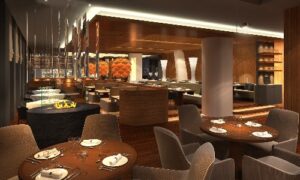Opening a restaurant is an exciting venture, but it comes with many challenges, including one crucial aspect: selecting the right restaurant equipment. The efficiency, productivity, and safety of your kitchen all depend on the quality and type of equipment you invest in. Whether you’re opening a new restaurant or upgrading an existing one, the right tools can make a significant difference in how smoothly your kitchen operates.
In this comprehensive guide, we will cover everything you need to know about restaurant equipment, highlighting the essentials and providing insights on how to make the best decisions when equipping your restaurant.
Why the Right Restaurant Equipment Matters
A successful restaurant is more than just a great chef and a creative menu. The backbone of any kitchen lies in the equipment that supports the cooking and preparation processes. Investing in high-quality equipment for restaurant kitchens not only improves workflow and safety but also ensures consistent food quality, which is crucial for customer satisfaction.
The right equipment can also increase efficiency, reduce waste, and minimize energy costs. For example, energy-efficient appliances can significantly lower your utility bills, while advanced cooking technology can help streamline preparation times, leading to faster service.
On the other hand, poor-quality or inappropriate equipment can lead to issues such as inconsistent food preparation, increased maintenance costs, and slower service, all of which can negatively affect your bottom line.
Essential Restaurant Equipment for Your Kitchen
To help you create a productive and efficient kitchen, here’s a breakdown of the most important restaurant equipment you should consider:
1. Refrigeration Equipment
One of the most critical pieces of equipment for restaurants is refrigeration. Maintaining the freshness of ingredients is essential, and refrigeration units ensure that perishables remain safe for consumption.
- Commercial Refrigerators: Unlike domestic refrigerators, commercial units are designed to withstand frequent use and maintain temperature consistency even with constant opening and closing. Choose the right size and type (walk-in, reach-in, or under-counter) based on your kitchen’s needs.
- Freezers: Commercial freezers are necessary for storing bulk purchases or items that need long-term storage. Similar to refrigerators, they come in various sizes and configurations.
- Refrigerated Prep Tables: These tables are perfect for sandwich or salad stations, keeping ingredients chilled and within reach while providing a work surface for preparation.
2. Cooking Equipment
High-quality cooking equipment is the foundation of any successful kitchen. Depending on your menu, you will need different types of cooking equipment, but these are the basics:
- Ranges: A commercial range is a must-have for any restaurant. You can choose from gas or electric ranges, with various configurations of burners, griddles, and ovens.
- Ovens: There are many types of ovens to choose from, including conventional ovens, convection ovens, pizza ovens, and combination ovens (which can bake, steam, and broil). The right type of oven depends on your restaurant’s needs.
- Grills and Griddles: These are essential for preparing grilled meats, vegetables, and sandwiches. A griddle offers a flat cooking surface, while a grill has ridges that leave sear marks.
- Deep Fryers: If your restaurant serves fried foods like French fries, chicken wings, or tempura, a commercial-grade fryer is essential. Choose a model with sufficient capacity and safety features like automatic shut-off.
- Steamers: Steam cooking is healthier and faster, making it a popular choice for many kitchens. Steamers are great for vegetables, seafood, and rice.
3. Food Preparation Equipment
Prepping ingredients is a time-consuming task, so investing in reliable equipment for restaurant food preparation can greatly enhance efficiency.
- Food Processors: These versatile machines can chop, grind, slice, and puree ingredients, making them a must-have for any busy kitchen. You can find various sizes depending on your volume needs.
- Mixers: Commercial mixers are essential for bakeries and restaurants that make bread, dough, or batters. Planetary mixers are the most common type, while spiral mixers are ideal for large dough batches.
- Blenders: Whether you’re making smoothies, sauces, or soups, a commercial blender will help you achieve the right consistency.
- Cutting Tools: Mandolines, choppers, and slicers will save time in slicing vegetables, meats, and cheeses.
4. Storage and Shelving
Proper storage is essential for maintaining a clean and organized kitchen. You will need durable storage solutions that can handle the demands of a busy restaurant.
- Shelving Units: Invest in sturdy shelving units to store dry goods, ingredients, cookware, and small appliances. Wire shelving is a popular choice for its durability and ventilation.
- Storage Bins: These are great for storing bulk ingredients like flour, sugar, and rice. Make sure to label everything clearly to prevent confusion and contamination.
- Racks: Commercial kitchens often use bun racks or speed racks to hold trays of prepared or baked goods. They are also handy for storing sheet pans and cooling baked items.
5. Dishwashing Equipment
Maintaining hygiene in a restaurant kitchen is non-negotiable, and dishwashing equipment plays a significant role in keeping things clean and sanitized.
- Dishwashers: Commercial dishwashers are faster and more efficient than residential models, with options like high-temperature or low-temperature units. Ensure that your dishwasher meets health codes and is capable of handling your volume of dirty dishes.
- Three-Compartment Sinks: In many regions, health codes require a three-compartment sink for washing, rinsing, and sanitizing dishes manually. Stainless steel sinks are durable, easy to clean, and can withstand heavy use.
6. Serving and Holding Equipment
Once your food is cooked, you need equipment to hold and serve it to customers in a timely and presentable manner.
- Heat Lamps: Heat lamps are essential for keeping cooked food warm until it’s ready to be served. These are often placed on the pass to ensure that dishes remain at the correct temperature before being sent out.
- Food Warmers: Holding cabinets or food warmers are excellent for keeping prepared food at the right temperature, which is especially useful for catering services or during busy meal periods.
- Chafing Dishes: These are popular for buffet-style serving. They keep food warm and can be used for a variety of dishes, from soups to entrees.
7. Beverage Equipment
Beverage service is a vital part of most restaurant operations, especially if you serve coffee, tea, juices, or alcoholic beverages.
- Coffee Machines: For restaurants that serve breakfast or operate all day, a commercial coffee machine is essential. Depending on your customer volume, you can choose from drip coffee makers, espresso machines, or pod-based brewers.
- Juice Dispensers: If your restaurant offers fresh juices or smoothies, a high-capacity juice dispenser will make it easy to serve cold drinks quickly.
- Ice Machines: Ice is needed for drinks, and you may need a high-capacity ice maker to meet customer demand. Ensure you choose the right size based on your daily usage.
8. Safety and Sanitation Equipment
In addition to ensuring the quality of your food, you also need to focus on safety and cleanliness. Proper sanitation equipment will help you maintain a clean kitchen and adhere to health regulations.
- Handwashing Stations: A dedicated handwashing sink is a must for any commercial kitchen. These should be easy to access and equipped with soap dispensers and hand dryers or paper towels.
- First Aid Kits: Keep a fully stocked first aid kit in case of accidents, which can happen frequently in a busy kitchen.
- Fire Safety Equipment: Invest in fire extinguishers, hood suppression systems, and fire-resistant clothing for your staff to comply with fire safety regulations.
9. Point of Sale (POS) Systems
While not a kitchen-specific tool, a modern Point of Sale (POS) system is critical to managing orders, sales, and inventory efficiently. A reliable POS system can streamline communication between the front-of-house and back-of-house, improve order accuracy, and provide valuable insights into sales trends.
Choosing the Right Equipment for Your Restaurant
When it comes to selecting the right equipment for restaurant kitchens, consider the following factors:
- Menu Requirements: Tailor your equipment to your menu. For instance, if your menu heavily features grilled items, a high-quality grill or griddle will be a priority.
- Space: Measure your kitchen and ensure that you select equipment that fits without overcrowding the space. A well-organized kitchen allows for smoother operation.
- Energy Efficiency: Choose energy-efficient appliances to save on utility costs. Many commercial appliances have energy-saving features that make a big difference over time.
- Quality and Durability: Commercial kitchen equipment takes a lot of abuse, so it’s important to choose durable, high-quality equipment from reputable manufacturers.
- Warranty and Support: Check the warranty and availability of support services before purchasing. A long warranty and access to maintenance services can save you a lot of hassle down the road.
Conclusion
Equipping your kitchen with the right restaurant equipment is a critical step in running a successful restaurant. From refrigeration and cooking tools to food preparation and safety gear, each piece of equipment plays a vital role in ensuring smooth operations and delivering high-quality meals to your customers.
When choosing equipment for restaurant kitchens, consider your menu, space, energy efficiency, and durability. Making smart investments upfront will not only improve the efficiency of your kitchen but also save you money in the long run by reducing maintenance costs and energy consumption.


































